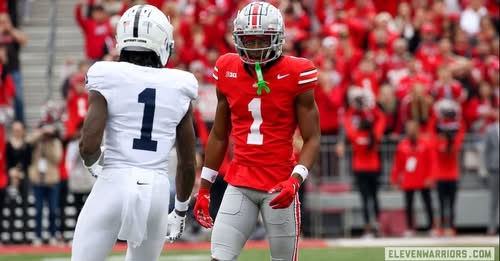k we probably know what’s going to happen around game time for that one,” Ross Bjork said with a wry smile, eyes glinting with both resignation and understanding. The Texas A&M athletic director, now comfortably settled into his new role as Ohio State’s athletic director, didn’t need to elaborate for anyone with even a cursory understanding of the Big Ten’s media landscape. His cryptic but confident assessment was about the anticipated kickoff time for what has become one of the conference’s most pivotal annual matchups: Ohio State vs. Penn State. And the implication was clear — another marquee showdown between two of the Big Ten’s biggest brands was almost certainly bound for a noon kickoff on FOX’s “Big Noon Saturday.”
To fans who have followed the ebb and flow of college football over the last decade, the scenario is all too familiar. The expansion of television rights deals, particularly the Big Ten’s landmark multi-billion-dollar agreement with FOX, CBS, and NBC, has dramatically reshaped the scheduling traditions of college football Saturdays. Noon kickoffs, once reserved primarily for regional matchups and games of modest national interest, have now become the new primetime in the eyes of network executives. For FOX Sports, in particular, the noon Eastern window has become their flagship timeslot, the place where they plant their biggest banner and shine their brightest spotlight. And more often than not, Ohio State has found itself under that light.
For Ohio State, the noon window has become something of a home. Whether it’s Michigan, Michigan State, Penn State, or even crossover games against Wisconsin and Iowa, the Buckeyes are now familiar faces in early afternoon national broadcasts. And that familiarity has bred both fatigue and frustration among fans, players, and coaches alike. Though Ross Bjork’s comment may have been casual, it struck a nerve in a fanbase that has long desired — and believes it deserves — the pageantry and electricity that comes with a night game at The Horseshoe. A clash between top-ten opponents like Ohio State and Penn State under the lights in Columbus, with the fans clad in scarlet and gray and the atmosphere crackling with primetime energy, feels like the kind of spectacle that should be reserved for 7:30 p.m. Yet, as has been the case so many times before, those dreams will likely give way to the reality of a noon start and the corporate priorities that underpin it.
Bjork’s nod to the obvious reflects both his own media savvy and the complicated dynamics of the Big Ten’s new media deal, which was announced to great fanfare but has produced its fair share of headaches. The deal, which includes FOX as a primary rights holder alongside CBS and NBC, prioritizes major games for the noon slot on FOX, afternoon coverage on CBS, and primetime games on NBC. In theory, this allows for an all-day showcase of Big Ten football across three national networks. In practice, however, it has resulted in a consistent tug-of-war over time slots, with FOX maintaining its vice grip on the noon window and using Ohio State as its marquee draw to anchor the time period.
For Ohio State fans, this isn’t merely a matter of preference; it’s a matter of identity. Night games at The Horseshoe are a beloved tradition. They represent a different level of spectacle — an atmosphere that doesn’t just feel special but feels definitive. Night games are where legends are made and memories are etched into the annals of college football history. From the roaring crowds to the cool fall air, to the way the stadium glows under the lights, everything about a night game is meant to evoke drama, grandeur, and epic consequence. Noon kickoffs, by contrast, often feel antiseptic in comparison — rushed, routine, and drained of some of the mystique that defines college football’s most iconic matchups.
But television dictates reality now, and television wants Ohio State vs. Penn State to kick off at noon. The reason is simple: ratings. FOX’s “Big Noon Saturday” has consistently drawn massive audiences, particularly when the Buckeyes are involved. The strategy, launched a few years ago, was aimed at avoiding the crowded primetime landscape dominated by ABC/ESPN and SEC matchups. By putting their biggest game at noon, FOX could stake a claim to an uncontested time window and draw national attention without having to go head-to-head with other marquee broadcasts. And the results have validated the strategy. Ohio State games at noon consistently rank among the most-watched college football games each year.
Yet for all the ratings success, the fallout hasn’t been without consequence. Fans across the conference — not just at Ohio State, but at Michigan, Penn State, and elsewhere — have voiced displeasure over early kickoffs that complicate travel plans, dilute game day traditions, and shorten tailgate experiences. The noon slot has become symbolic of an increasing tension between the traditions of college football and the commercial forces that seek to reshape it. In this new era, decisions are made not based on what enhances the in-stadium experience or what feels right for the moment, but rather what best serves the bottom line of media conglomerates and the ratings ecosystem they inhabit.
Ross Bjork is not the first Big Ten administrator to speak to this tension, but he may be among the most frank. His casual remark suggests a resigned acceptance of the dynamics at play, an understanding that as long as FOX owns the noon window, Ohio State — as the conference’s biggest television draw — will often be the sacrificial lamb offered up at high noon. And that resignation is shared by many within the Ohio State program, even if it’s rarely expressed in public statements.
Coaches, especially, have been forced to adapt. Noon kickoffs drastically alter a team’s preparation routine. The early wake-up calls, condensed walkthroughs, and adjusted meals can disrupt rhythm and preparation. While all teams must contend with these adjustments when assigned early start times, it is a more acute issue for games of the magnitude of Ohio State vs. Penn State — where every edge, every detail, and every ounce of preparation could swing the outcome. Players, too, are affected. They thrive on energy, on the slow build-up of anticipation that a later kickoff allows. Noon games deny them that runway, forcing them to hit full speed shortly after breakfast.
There’s also a recruiting dimension to the kickoff conundrum. Night games offer programs a chance to showcase their best selves to high school recruits who visit campus. The electric atmosphere of a primetime game, the fireworks, the light shows, the full-throated crowd — these are critical tools in winning over the next generation of talent. Noon games, by contrast, often feel flat in comparison. The crowd is less rowdy, the tailgates more subdued, and the spectacle less impressive. For a program like Ohio State, which recruits nationally and battles blue bloods across the country for elite talent, every missed opportunity to dazzle matters.
Still, the counterargument is grounded in cold, hard data. FOX’s noon slot delivers viewers — millions of them. And in an age where the business of college athletics is increasingly dependent on television revenue, those viewers translate directly into dollars. The Big Ten’s media deal is worth billions, and its structure ensures that all schools — including those not named Ohio State — benefit from the ratings power that the Buckeyes provide. In that sense, Ohio State’s sacrifice at the altar of noon kickoffs is, paradoxically, part of what elevates the entire conference. The success of “Big Noon Saturday” helps justify the enormous financial commitment networks have made to Big Ten football, which in turn supports everything from Olympic sports to facility upgrades across the league.
This tension — between what’s best for television and what’s best for tradition — is not unique to Ohio State or the Big Ten. It’s a story playing out across the college football landscape as conferences realign, rivalries are upended, and game times are set based not on history or geography but on broadcast desirability. It’s a story of a sport in flux, caught between its roots and its rapidly approaching future. And at the center of that story, Ohio State remains both a beneficiary and a victim — reaping the rewards of its immense drawing power while bearing the burden that comes with it.
So when Ross Bjork says, “I think we probably know what’s going to happen around game time for that one,” it isn’t just a throwaway line. It’s a reflection of a reality that Ohio State fans know all too well. It’s the voice of an administrator who understands that the levers of power in college football are increasingly controlled not by athletic departments or fan bases, but by television executives and corporate partnerships. It’s a reminder that in the modern era of college athletics, even something as seemingly simple as a kickoff time is governed by a complex web of commercial interests and strategic calculus.
As Ohio State and Penn State prepare once again to square off in a game with conference title implications and national playoff reverberations, the kickoff time will serve as more than just a scheduling detail. It will be a statement — one that encapsulates the priorities of the sport, the influence of television, and the evolving identity of college football in the 21st century. Noon, in this context, is no longer just a time on the clock. It’s a symbol. And for better or worse, it’s the reality that programs like Ohio State must now navigate, every single fall Saturday.



